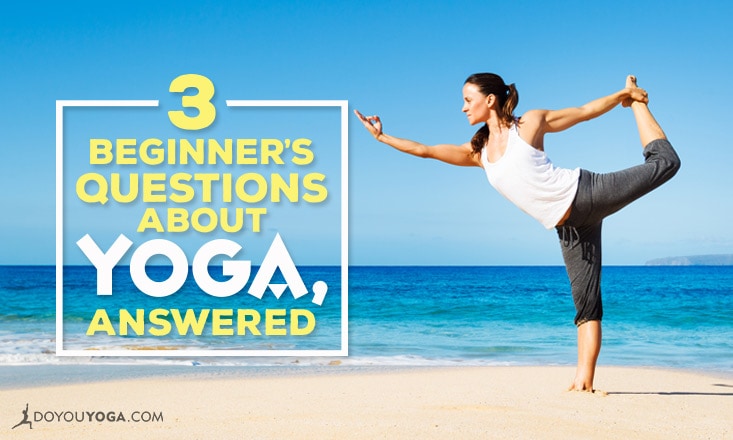Ever sit in your yoga class and ask yourself, “What the heck did the teacher just say?” Never fear, you’re in good company. It’s quite possible a lot of your classmates think that way, too. And it’s totally fine!
Teachers all acquire their own instruction methods and techniques stemming from their history, experiences, and training. This means diversity in opening a class, in cueing through your poses, and finally, in closing with your Savasana.
Now, you’ve got a lot to cover in 50 to 90 minutes, and chances are your teacher wants to explain everything, but there’s a lot going on in class, from getting to know your past injuries to modifying for a pregnant student.
No worries! Have a quick read and you’ll catch up beautifully, just in time for your next Utkatasana.
1. Why do we chant ‘Om’ before class?
So you finally get your seated position down. And by down, I mean comfortable enough so your foot doesn’t fall asleep. The teacher says you will chant ‘Om’ with your class. Why? You barely have the nerve for karaoke with your friends. Why would you want to chant anything with a group of strangers?
The truth is chanting is not singing. No one is judging your showmanship as if you were on “American Idol.” Eyes are closed. The vibrational energies of ‘Om’ or ‘Aum’ are believed to create a calming effect that starts in the throat and vibrates into your head.
This outpouring of calming energy is thought to restore balance to the entire body before you begin your mental and physical practice. If chanted in a deep monotone, you will begin to feel the vibrations trickle out to your extremities.
A look at the history of yoga will introduce you to Patanjali’s Yoga Sutras, and there is an entire Upanishad dedicated to the study and breakdown of ‘Om.’
But before you pull out your Sanskrit-English dictionary, consider this. The practice of yoga describes ‘Om’ as the sound and vibration that mimics the moment of universal creation which is eerily reminiscent of the Big Bang Theory. Pretty cool how that comes full circle, huh?
And if ‘Om’ sets the universe at its original equilibrium, perhaps it can do the same for you.
2. Isn’t yoga supposed to be all about fancy poses?
So you sign up for this killer Vinyasa class your coworker has been bragging about. You’ve heard great things and can’t wait to feel the burn.
But before you see the calories melting off, your teacher has you sit quietly. The silence is so deafening you can’t help but start to fidget. You haven’t had a still moment all day. Your mind is still racing over all those emails you left unchecked before your lunch hour.
Then, your instructor takes you through a series of stretches that leaves you wondering if you’ll ever break a sweat. True, your hamstrings have never felt more heavenly but “When do I get to rival the talents of a gymnast with my tricks?” you ponder.
Before long, you have toppled over trying to hold Tree Pose, but then again, so have many of your classmates. In fact, the next time you attempt Tree Pose you will recognize your muscles getting stronger and you may find yourself shaking less.
You’re lying in Corpse Pose at the completion of class and a feeling of euphoria sets in. The motions you’ve gone through are still vivid in your mind and you are proud to be at home in your own body vessel. You see all your hard work as progress and ‘I can’t’ or ‘I didn’t’ just doesn’t apply.
And, if even for a fleeting moment, you are truly present. Earbuds out, with only the sound of your inhales and exhales filling your atmosphere, you have joined the global millions who have come to find that yoga is so much more than fancy poses.
3. Why do we bow and say ‘Namaste’ so much in yoga?
Yoga is available to anyone regardless of caste, sex, religion, belief, culture, tradition, and any other degree of separation. We start as equals. Humans create labels to segregate ourselves from our own brothers.
In yoga, we put our hands together in Anjali Mudra (prayer position). The gesture can be at the heart or in the middle of the forehead where it is believed your third eye is located. The third eye is your consciousness’ potential to achieve enlightenment.
Think of the greatness a pianist taps into to compose a masterpiece that transcends space and time. Think of what he sees and imagines out of the tangible box.
And as humans, we all possess this capability of higher enlightenment. We say ‘Namaste’ as a greeting, or upon a departure. It translates simply to “The divine in me recognizes the divine in you.”
Understanding your yoga class may seem like you are deciphering an ancient language at times. Okay, that’s exactly what you are doing at all times. But with practice, your poses will come more naturally, and, in time, you may find yourself more present and more peaceful in other areas of your life.
You will come to appreciate the calming effects of ‘Om’ on your nervous system, and you will look at all life with a sense of ‘Namaste.’ So, what are you waiting for? Your best yoga class yet awaits you.


